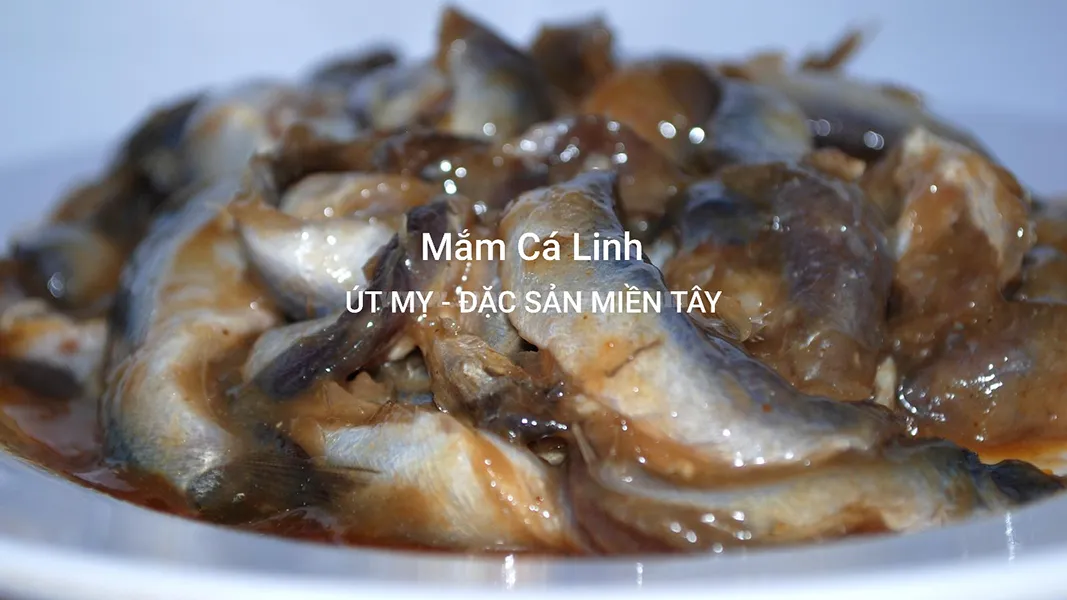The Mekong Delta, known for its lush orchards and endless rice paddies, is also a cradle of unique and flavorful cuisine. Among its countless delicacies, fermented fish paste (Mắm cá linh) stands out as an icon, a distinctive taste that lingers in the memory of anyone who has tried it. This rustic dish is not only a source of pride for the people of the Mekong Delta but also an indispensable part of Vietnam’s culinary culture.
Mekong Delta Fermented Fish Paste: Essence of Nature’s Bounty
Mắm cá linh is a specialty of the Mekong Delta region, made from linh fish – a small, flat-bodied fish that appears only during the flood season (July to October in the lunar calendar). Fresh linh fish, caught from the intricate network of rivers and canals, undergo a meticulous and elaborate processing to become a fragrant and savory fermented fish paste.
The linh fish used for making mắm must be fresh, thick-bodied, and not spoiled. After being caught, the fish are washed, drained, and then salted in a specific ratio. Depending on family recipes passed down through generations, this ratio may vary, but it is usually about 3-4 parts fish to 1 part salt.
After salting, the fish are placed in jars or earthenware pots, tightly sealed, and carefully weighted down. The salting process usually lasts about a month, during which the fish ferments and releases fish sauce. After 1 month, the fish is taken out, mixed with thính (roasted rice powder) and sugar, and then fermented for another 40-45 days.

The final step is to put the fish that has been fermented with thính into jars, pour a thick layer of caramelized sugar syrup over it, alternating layers of fish and sugar syrup. After about 2 months, the fermented fish paste will be ready, with a reddish-brown color, a distinctive aroma, and a harmonious salty-sweet taste.
Diverse Ways to Enjoy Fermented Fish Paste
Mắm cá linh can be prepared into many different dishes, each with its own unique flavor, but all rich and appealing.
- Fresh Fermented Fish Paste (Mắm sống): This is the simplest way to eat it, yet it is favored by many. The fermented fish paste is scooped into a bowl, a little sugar, minced garlic and chili are added, a squeeze of lime is added, and then it is all mixed well. This dish is delicious when served with fresh herbs and vegetables, fresh rice vermicelli, or star fruit. The blend of salty, sweet, spicy, and sour flavors, along with the distinctive aroma of the fermented fish paste, creates an unforgettable culinary experience.
- Steamed Fermented Fish Paste (Mắm chưng): Fermented fish paste steamed with minced pork, chicken eggs, and wood ear mushrooms is a familiar dish in Mekong Delta family meals. This dish has the richness of eggs, the sweetness of pork, the aroma of mushrooms, and the savory flavor of the fermented fish paste, making it very delicious with hot rice.
- Braised Fermented Fish Paste (Mắm kho): Fermented fish paste braised with pork belly, eggplant, winged beans, and other vegetables is a typical Mekong Delta dish during the flood season. This dish has the saltiness of the fermented fish paste, the richness of the pork, and the natural sweetness of the vegetables, and is unmatched when served with hot rice and fresh herbs and vegetables.
- Fermented Fish Hot Pot (Lẩu mắm): Fermented fish hot pot is a famous dish of the Mekong Delta, cooked with many different types of fermented fish paste, among which fermented linh fish paste is indispensable. Fermented fish hot pot is rich, flavorful, and delicious, served with many kinds of vegetables, meat, and seafood.

Tips for Choosing Delicious Fermented Fish Paste
To get delicious fermented fish paste, choosing the ingredients plays a crucial role.
- Choose the fish: Choose fresh, thick-bodied linh fish that are not spoiled. The fish must be whole and not crushed.
- Color: Good fermented fish paste usually has a reddish-brown color, not black or dull.
- Smell: Good fermented fish paste has a distinctive aroma, not rancid or with strange odors.
- Consistency: Good fermented fish paste has a moderate consistency, not too watery and not too thick.
In addition, you should choose to buy fermented fish paste from reputable addresses with clear origins to ensure quality and food safety.
Fermented Fish Paste: A Meaningful Gift from the Mekong Delta
Mắm cá linh is not only a delicious dish but also a meaningful gift that you can give to relatives and friends after a trip to the Mekong Delta. This gift carries the flavor of the river region, expressing the giver’s heart and helping the recipient feel the unique culinary culture of the Mekong Delta.
To preserve fermented fish paste for a long time, you should keep it in a dry, cool, and ventilated place, away from direct sunlight. After opening the lid, it should be tightly closed and stored in the refrigerator.

Conclusion
Mekong Delta fermented fish paste is not just a dish, but also a part of the culture, history, and people of this region. The rich and distinctive flavor of fermented linh fish paste has conquered many diners and become a source of pride for the people of the Mekong Delta. If you have the opportunity to visit the Mekong Delta, don’t forget to enjoy this specialty and bring it back as a gift for your loved ones and friends. Surely, the taste of fermented fish paste will make you forever remember a fertile, hospitable, and culturally rich land.